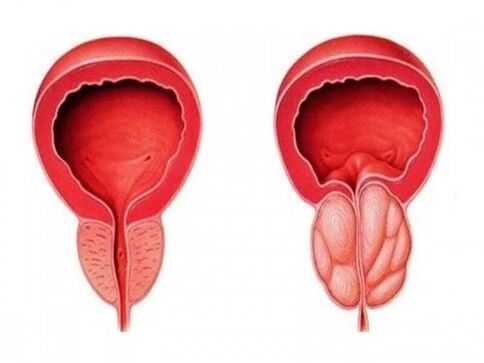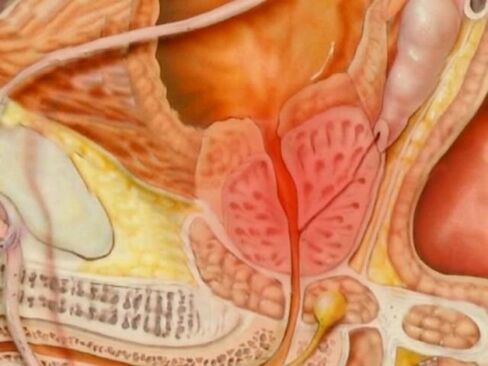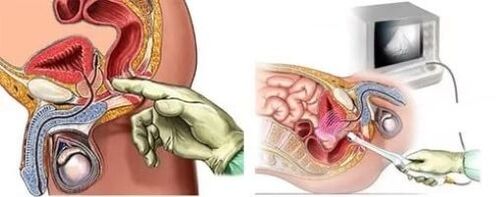Prostatitis is a type of prostatitis that affects men 20 years and older.
According to statistics, a quarter of men have experienced this disease in one form or another. In recent years, there has been a trend to "rejuvenate" the process. This is due to sexual liberation, the increase in sexually transmitted infections, the trend of self-diagnosis and treatment on the Internet, and the resistance of infectious agents to antibiotic treatment.
This is particularly true, because the initial signs of male prostatitis are usually eliminated, which does not allow for timely treatment, and in some cases can lead to the development of advanced prostatitis.
Signs of male prostatitis

The characteristics of prostate structure, blood supply, and location affect the nature of the symptoms that cause inflammation. These include:
- Pain symptoms.
- Symptoms of dysuria (painful urination).
- Symptoms of erectile dysfunction.
Pain symptoms
Pain of different intensities can disturb people in the lower abdomen, perineum, genitals, waist and spine. The location of the pain is due to the presence of neural connections and the involvement of seminal vesicles (vesicles) in the inflammatory process.
The intensity of the pain may vary, from the inexplicable discomfort to the severe pain that affects the man's mental state and causes insomnia. The painful feeling depends on sexual behavior and is caused by lack of regular ejaculation or vice versa. It is related to the spread of inflammatory processes in the back of the urethra.
Please note that the pain in the lumbar pain area may not be related to the prostate, but may be the result of osteochondrosis of the spine, for example. The results of talking with the patient and the data from the urological examination help determine the cause of this pain.
The first symptom of male prostatitis is pain that spreads along the epididymis (left and right groin area) to the testis (scrotum area). The pain radiated by the inflamed prostate may appear on the inner thighs and back, which indicates that a neurologist needs to be consulted. To rule out neuropathology, because this spread is not typically for prostate pain.
In some cases, the painful irradiation is asymmetrical, which makes it possible to suspect that the inflammatory process of the prostate is located in one of its lobules. At the manifestation site, the pain syndrome is divided into the genitals (in the genital area). , Features of congestive chronic prostatitis), extragenital (above the genital organs), features of advanced advanced prostatitis) and mixed (chronic prostatitis).
Difficulty or dysuria and symptoms of prostatitis
Urination disorders are expressed by false desires. This feeling is incomplete bladder emptying, accompanied by frequent urination, which is related to inflammation of the bladder neck and urethra. Long-term signs of dysuria in prostatitis indicate that the process is chronic.
Erectile diseases and prostatitis

The erectile dysfunction of prostatitis is manifested as premature ejaculation, blurred feeling during orgasm, decreased libido, and weakened erection. Sometimes, a man's prostatitis can be suspected if he doesn't get an erection in the morning.
As the first symptom of male prostatitis, the decrease in efficacy is due to the decrease in the synthesis of testosterone (male sex hormone).
The manifestations of inflammation in the prostate are not limited to the above three symptoms. The first symptom of male prostatitis is usually the discharge of prostate secretions from the urethra during defecation (prostatic diarrhea), which indicates that the tension of the ejaculatory duct muscles is reduced.
In addition, one can only pay attention to the psychological symptoms of male prostatitis: debilitating neurological syndrome is developed from the nervous system (depression, fatigue, lack of desire to do things, physical weakness).
Initial signs of acute prostatitis

All the above symptoms are typical symptoms of chronic inflammation of the prostate. Men suffer from acute prostatitis, and the situation is different.
The disease begins with acute severe pain in the perineum, and the symptoms of urinary system diseases are more clearly tracked. The temperature rises to 38-39 C, chills, weakness, sweating, muscle and bone pain. Anal pain during defecation is worrying. No sex life.
If you do not pass the examination in time and do not start treatment, the acute process will be complicated by purulent prostatitis and may cause abscesses, which will lead to emergency surgery.
If there is no other reason (immune deficiency state, severe accompanying pathology, etc. )-male purulent prostatitis-advanced inflammatory process caused by the inability to seek medical attention in time!
Causes of signs of prostate inflammation
Traditionally, the factors affecting prostate inflammation are divided into 3 groups.
Factors that did not respond include:
- Body type.
- Sexual physique.
- Age factor.
- The existence of disease.
- Environment (climate factors).
Some controllable factors:
- Sexual habits.
- Occupation.
- Background disease of male genital area.
- Attitudes to disease.
Finally, controllable factors:
- Promiscuity.
- alcoholism.
- Failure to follow treatment recommendations.
- The power mode is wrong.
Who is in danger
Prostatitis can threaten the following men:
- Stick to a sedentary lifestyle.
- Suffer from chronic constipation.
- There is a history of sexually transmitted infections.
- Have more than one sexual partner.
- Suffering from alcoholism and drug addiction.
- They work in cold conditions.
What to do if there are signs of prostatitis
Laboratory diagnosis of prostatitis

- In KLA, the sedimentation rate of erythrocytes increases, and the leukocytes move to the left. In OAM-leukocytosis, proteinuria, bacteriuria.
- Blood is used for HIV infection.
- Usually, white blood cells are smeared on the urethral smear of the flora. If no STD pathogens (Neisser gonorrhoeae, trichomoniasis) are found, PCR diagnosis must be performed.
- Prostate secretions: Seed prostate secretions on pathogens and determine sensitivity to antibiotics.
- PCR-diagnosing sexually transmitted infections is the most reliable and fastest method to verify pathogens.
- PSA blood PSA (Prostate Specific Antigen) blood should not be taken during acute inflammation of the prostate, the results will be unreliable. It is best to perform this analysis one month after the end of treatment. Young people under the age of 30 do not need to check the PSA level in the blood. This test is very important for men over the age of 40, because in some cases, acute prostatitis may be secondary and malignant tumors in the prostateBe hidden behind its clinical manifestations.
Instrument diagnosis method

Usually, transrectal (through the rectum) or transabdominal (through the abdomen) ultrasound of the prostate is sufficient.
Ultrasound examination for signs of prostatitis

The glands increase in volume, texture, and edema; purulent prostatitis-necrotic areas, deformed contours, and increased regional lymph nodes.
What should you pay attention to
First of all, in order to get rid of the symptoms of prostatitis forever, certain eating habits must be followed.
The exacerbation of male prostatitis depends on the irritating substances in the food intake: spicy spices, vinegar, pickles, alcohol.
Special mention should be made of alcohol. Even the minimal use of alcohol can offset the effects of long-term complex treatments.
Some patients think that they should reduce the frequency of drinking, or switch to lighter alcoholic beverages. This is their main mistake.
Diluted vinegar, kvass, citrus fruits, sauerkraut, tomatoes and cucumbers are not harmful to prostatitis.
Eating fiber-rich foods will relieve a person's constipation-one of the main causes of congestion in the small pelvis.
Herbs help prevent. Taking herbal diuretics: bilberry leaves, dill seeds, and urological drugs help improve urination during inflammation.
Exercise, especially exercise that improves blood circulation in the pelvic organs, helps keep the prostate in good condition.
The development of prostate inflammation causes hypothermia. Winter clothes are worth warmer. After swimming in summer, do not put them in wet swimming trunks for a long time.
Using condoms during sexual contact with a stranger can protect you from sexually transmitted diseases including HIV infection.
Prolonged fatigue will have a negative impact on a man’s immune system and stress status, which will aggravate the dormant infection of the prostate. Regular preventive examinations by urologists will help maintain men’s health.



























